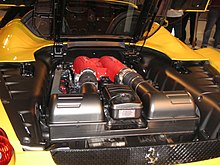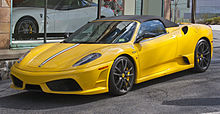
The Bentley Continental GT is a grand touring car manufactured and marketed by the British company Bentley Motors since 2003. A two-door coupé or convertible, it was the first new Bentley released after the company's acquisition by Volkswagen AG in 1998, and the first Bentley to employ mass production manufacturing techniques. It was later joined by the Bentley Continental Flying Spur, a four-door saloon car variant.
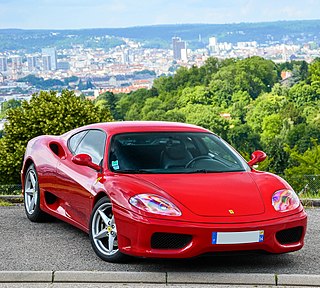
The Ferrari 360 is a two-seater, mid-engine, rear wheel drive sports car manufactured by Italian automotive manufacturer Ferrari from 1999 until 2004. It succeeded the Ferrari F355 and was replaced by the Ferrari F430 in 2004.

The Ferrari 575M Maranello is a two-seat, two-door, grand tourer manufactured by Italian automobile manufacturer Ferrari. Launched in 2002, it is essentially an updated 550 Maranello featuring minor styling changes from Pininfarina. The 575M was replaced by the 599 GTB in the first half of 2006.
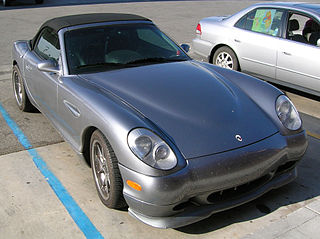
The Esperante is a sports car made by Panoz, an American car manufacturer.

The BMW M6 is a high-performance version of the 6 Series marketed under the BMW M sub-brand from 1983 to 2018.

The Ferrari 348 is a mid-engine V8-powered 2-seat sports car produced by Italian automaker Ferrari, replacing the 328 in 1989 and remaining in production until 1995, when it was replaced by the F355. It was the final V8 model developed under the direction of Enzo Ferrari before his death, commissioned to production posthumously.

The Aston Martin Vantage is a series of hand-built sports cars from the British automotive manufacturer Aston Martin. Aston Martin has previously used the "Vantage" name on high-performance variants of their existing GT models, notably on the Virage-based car of the 1990s. The modern car, in contrast, is the leanest and most agile car in Aston's lineup. As such, it is intended as a more focused model to reach out to potential buyers of cars such as the Porsche 911 as well as the exotic sports and GT cars with which Aston Martins traditionally compete.

The Porsche 911 GT3 is a high-performance homologation model of the Porsche 911 sports car. It is a line of high-performance models, which began with the 1973 911 Carrera RS. The GT3 has had a successful racing career in the one-make national and regional Porsche Carrera Cup and GT3 Cup Challenge series, as well as the international Porsche Supercup supporting the FIA F1 World Championship.

The Porsche 911 GT2 is a high-performance, track-focused sports car built by the German automobile manufacturer Porsche from 1993 to 2009, and then since 2010 as the GT2 RS. It is based on the 911 Turbo, and uses a similar twin-turbocharged engine, but features numerous upgrades, including engine enhancements, larger brakes, and stiffer suspension calibration. The GT2 is significantly lighter than the Turbo due to its use of rear-wheel-drive instead of all-wheel-drive system and the reduction or removal of interior components. As a result, the GT2 is the most expensive and fastest model among the 911 lineup.
The FIA GT3 European Championship was a sports car racing series organized by the Stéphane Ratel Organisation (SRO) and regulated by the Fédération Internationale de l'Automobile (FIA). It was a championship derived from the international FIA GT1 World Championship, but meant to provide competition for more amateur racers in closer to production cars. The series used extensive performance balancing and handicap weights to make cars more equal.
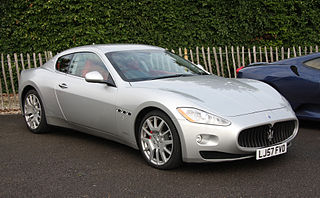
The Maserati GranTurismo and GranCabrio are a series of grand tourers produced by the Italian manufacturer Maserati, succeeding the Maserati Coupé and Spyder.

The Dodge Viper is a sports car that was manufactured by Dodge, a division of American car manufacturer FCA US LLC from 1992 until 2017, having taken a brief hiatus in 2007, and from 2010 to 2012. Production of the two-seat sports car began at New Mack Assembly Plant in 1991 and moved to Conner Avenue Assembly Plant in October 1995.

The Chevrolet Corvette C6.R is a grand tourer racing car built by Pratt Miller and Chevrolet for competition in endurance racing. It is a replacement for the Corvette C5-R racing car, applying the body style of the new C6 generation Chevrolet Corvette as well as improvements to increase the speed and reliability on the track. Since its debut in 2005, it has continued on from the previous dominance of the C5-R in its racing class with multiple American Le Mans Series championships and race wins in the Le Mans Series, FIA GT Championship, and 24 Hours of Le Mans. There are two main versions of the Corvette C6.R: the GT1 version which has 590 HP, carbon-ceramic brakes, and aggressive aerodynamics, and the GT2 version which has 470 HP, cast-iron brakes, and relatively stock aerodynamics with respect to the road car. Unrestricted though, the LS7.R engine will produce around 800 hp. By 2012 the C6.R GT1 was retired from the competition while the GT2 version continues to race around the world.

The Ferrari 458 Italia is an Italian mid-engine sports car produced by Ferrari. The 458 is the successor of the F430, and was first officially unveiled at the 2009 Frankfurt Motor Show. It was succeeded by the 488 GTB in 2015.

The McLaren MP4-12C, later known simply as the McLaren 12C, is a sports car that was designed and manufactured by McLaren Automotive. It was the first ever production car wholly designed and built by McLaren, and their first production road car since the McLaren F1, which was last built in 1998. The car's final design was unveiled in September 2009 and was launched in mid-2011.

The Mercedes-AMG GT is a series of 2-door grand tourers produced by German automobile manufacturer Mercedes-AMG. The car was introduced on 9 September 2014 and was officially unveiled to the public in October 2014 at the Paris Motor Show. While not directly replacing the SLS AMG, it is the second sports car developed entirely in-house by Mercedes-AMG. The Mercedes-AMG GT went on sale in two variants in March 2015, while a GT3 racing variant of the car was introduced in 2015. A high performance variant called the GT R was introduced in 2016. A GT4 racing variant, targeted at semi-professional drivers and based on the GT R variant, was introduced in 2017. In 2021, a new variant called the AMG GT Black Series was released. All variants are assembled at the Mercedes-Benz plant in Sindelfingen, Germany.

The Ferrari 488 is a mid-engine sports car produced by the Italian automobile manufacturer Ferrari. The car replaced the 458, being the first mid-engine Ferrari to use a turbocharged V8 since the F40. It was succeeded by the Ferrari F8.

The Scuderia Cameron Glickenhaus SCG 003 is a limited edition sports car and racing car developed and manufactured by American boutique car maker Scuderia Cameron Glickenhaus LLC. First announced as P33 in 2013, the SCG 003 was launched in 2015 at the Geneva Motor Show.

The Aston Martin Vantage is a two-seater sports car built by British manufacturer Aston Martin since 2018. It replaces the previous model which had been in production for 12 years.




